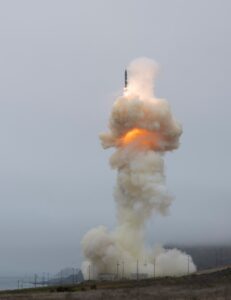The Senate Armed Services Committee’s (SASC) version of the FY ‘22 defense authorization bill would allow the Missile Defense Agency to continue developing and deploy the planned Next Generation Interceptor (NGI) but adds reliability and accountability requirements.
“The committee recommends a provision that would authorize the Director of the Missile Defense Agency, subject to the availability of appropriations, to develop a highly reliable missile defense interceptor for the Ground-based Midcourse Defense system using sound acquisition practices,” the committee’s bill report said.

This provision requires the MDA director to develop a funding plan addressing certain features of the program, submit a report on the funding profile necessary for the program with the FY ‘23 budget request, and notify the Congress within 30 days of any final decisions to cancel NGI.
“The committee recognizes that the threat of long-range missile attacks against the United States continues to increase, with growing risks from adversary acquisition of greater numbers of more complex systems with the capability to hold the U.S. Homeland at risk. In order to pace this threat, the capabilities of the United States’ Ground-based Midcourse Defense system must continue to evolve, even as the United States works to develop future defensive technologies,” the report said.
Last March, MDA awarded teams led by Lockheed Martin [LMT] and Northrop Grumman [NOC] for initial technology development and risk reduction contracts of the NGI. Both companies won contracts that, if all options are exercised, would reach almost $4 billion each (Defense Daily, March 23).
The NGI effort replaces the cancelled Redesigned Kill Vehicle, which planned to procure 20 new units. This is in addition to the 44 Ground-Based interceptors (GBIs) currently used by the Ground-based Midcourse Defense System.
Unlike the former program, NGI will feature a new kill vehicle and booster rocket. MDA plans to start testing the NGI ins 2025-2026 and start placing the 20 interceptor missiles in silos at Fort Greely, Alaska by 2027-2028
This bill report said MDA should conduct critical parts testing before the preliminary design review to maximize reliability, producibility and manufacturability; commence “rigorous flight testing” of NGI once essential components reach technology readiness level seven or higher; and complete at least two successful intercept flight tests before starting the first lot of production.
The bill also said the MDA director shall develop a funding plan that begins deployment of NGI as early as practicable given the above measures, but also includes transition plans to “replace the current inventory of silo-based boosters with follow-on systems prior to the end of their useful lifecycle.” This would mean planning to upgrade the booster rockets of existing GBIs, separate from updating their kill vehicles.
Beyond the provision approving of moving forward with NGI, the SASC bill has a provision requiring the MDA director “to develop and execute a plan for conducting annual reliability testing for the Next Generation Interceptor (NGI) within five years of a declaration of initial operational capability and ensure at least one test a year is performed in an operational setting for the ground based mid-course missile defense,” the report said.
This also requires the MDA director to provide a report to the Congressional defense committees on the estimated costs for conducting the tests, including procurement of “sufficient assets to accommodate testing of one interceptor per year over the life of the system.”
The report would be due no later than the date of approval for the NGI program to enter the production phase of the acquisition process.
The Senate panel included a third set of provisions for NGI, focused on “accountability matrices.”
Specifically, the bill includes a provision that requires the MDA director to submit a matrix that identifies key milestones, development events, specific performance goals, cost tracking, and independent reviews for the technology and product development phases of the Next Generation Interceptor (NGI) program in six-month increments. This is due to be submitted annually with the president’s budget request.
This measure also requires the director to update these annual matrices within 180 days after each submission and directs the Comptroller General of the U.S. to review the annually submitted matrices and brief the defense committees within 60 days of receipt.
However, these requirements would end one year after NGI reaches initial production.